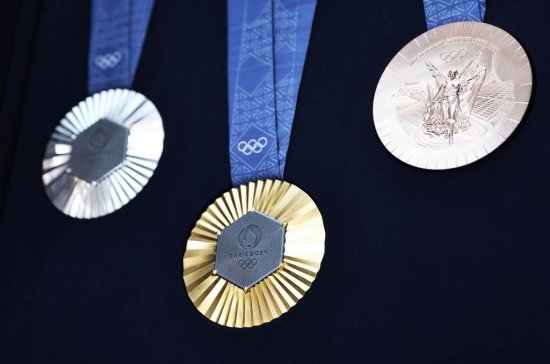
Winning a medal at the Games is an incredible accomplishment. But have you ever wondered what the medals are really made of?
Winning a gold, silver, or bronze medal at the Olympic or Paralympic Games is an incredible accomplishment. But have you ever wondered when the tradition of awarding medals started, what the medals are really made of or how much they are worth?
TIME is here to answer your questions about the medals.
- Welcome to the Noah Lyles Olympics
- The Best Photographs From the Paris Olympics
- The Cost of Attending the 2024 Paris Olympics
- See How Many Medals Every Country Won at the Paris Olympics—So Far
- Why Are the Olympics Held Every Four Years?
- Snoop Dogg on His Olympic Gig and Being a ‘Very Legal Guy’
- Get Our Olympics Newsletter in Your Inbox
When did the tradition of awarding medals start?
When the Games were revived in 1896 in Athens, first-place winners were awarded a silver medal, an olive branch, and a diploma, according to the International Olympic Committee (IOC). Athletes who placed second received a bronze or copper medal, as well as a branch of laurel and a diploma.
[time-brightcove not-tgx=”true”]The first time gold, silver, and bronze medals were awarded for first, second, and third place was in 1904, when the Games were held in St. Louis, according to the IOC.
What are the medals made of?
Despite its name, the gold medal is not entirely pure gold. In the last summer Olympic Games, which took place in Tokyo in 2021, the gold medal was mostly made up of pure silver, with more than 6 grams of gold plating, according to the IOC. The silver medal consisted of pure silver. Meanwhile, the bronze medal consisted of about 95% copper and 5% zinc. The medals for the Tokyo Games were made from metal extracted from recycled consumer electronics, according to the IOC. At the 2016 Rio de Janeiro Summer Olympic Games, the silver and bronze medals made for the Games consisted of about 30% recycled materials, the IOC said.
The Paris 2024 Organising Committee for the Olympic and Paralympic Games didn’t reply to a request for information about the specific composition of this year’s medals.
For this year’s Games, each medal also has a piece of original iron from the iconic Parisian monument: the Eiffel Tower, according to the official website of the Paris 2024 Games. As the tower has undergone many renovations over the years, some pieces have been removed and conserved. The Eiffel Tower Operating Company allowed these original pieces to be used for the Olympic and Paralympic medals this year.
Read More: Why Are the Olympics Held Every Four Years?
What do this year’s medals look like?
The design of the medals change for each edition of the Games.
This year, the iron from the Eiffel Tower has been formed into a hexagon—the geometrical shape of France, according to the website for the Paris 2024 Games. The iron has been stripped of its “Eiffel Tower brown” paint, and is its original dark gray color. It sits in the center of one side of both the Olympic and Paralympic medals, and has the emblem of the Paris 2024 Games imprinted on it. On the same side of the medal, lines the color of the type of medal—gold, silver, or bronze—extend out from around the iron hexagon, according to the website. Six metal appendages set the hexagon in its place at the center of the medal.
The other side of the Olympic medals depict the story of the rebirth of the Games in Greece, according to the website for the Paris 2024 Games. A traditional characteristic since 2004, the Greek goddess of victory, Athena Nike, is depicted on the medals, as is the Panathenaic Stadium, where the Games were revived in 1896. The Acropolis of Athens is also represented on the medals, along with the Eiffel Tower.
Meanwhile, the other side of the Paralympic medals depict the Eiffel Tower from an upward angle, according to the website. The words “Paris” and “2024” are engraved around the feet of the tower in universal Braille—both a reference to accessibility and its French inventor, Louis Braille. Dashes are also engraved on the edge so that athletes who have visual impairments can feel the difference between the medals—I for gold, II for silver, and III for bronze.
The Olympic medal ribbons are dark blue. The Paralympic medal ribbons are a deep red, which is a combination of the first two paint coats that were used on the Eiffel Tower, according to the website for the Paris 2024 Games. The ribbons for the medals for both Games are also decorated with the Eiffel Tower lattice work.
How much do the medals cost?
The website for the Paris 2024 Games doesn’t specify how much each medal costs. But based on the value of gold and silver, a gold medal likely costs about $750 to $850, as reported by NBC Sports. A silver medal is likely worth about $450, while a bronze medal may be valued at about $5, CNN previously reported.
But the medals are a symbol of achievement, and, when they have been sold, have gone for much higher prices—in 2021, a first-place medal from the 1896 Athens Olympic Games sold for more than $180,000, outlets reported at the time. Over the years, athletes have sold their medals amidst financial hardship, or to raise money for charities.